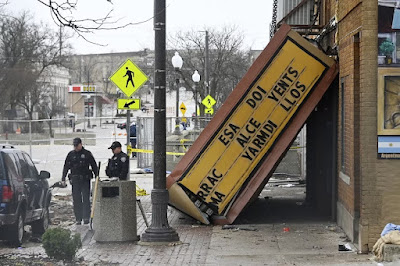WASHINGTON -- The death toll from a major storm system that has lashed the south-central and eastern United States with devastating winds and powerful tornadoes rose to at least 24 by Sunday, officials said.
Tennessee, one of the hardest-hit states since the storms began Friday, initially had seven weather-related fatalities, but it later rose to nine, according to Memphis-based news channel WREG.
Scenes of devastation were left in the path of the Tennessee tornado, which twisted trees, flattened homes into piles of wooden boards, and ripped walls from still-standing structures.
"The whole house, you can feel it shaking," said Janice Pieterick, whose house doors and glass windows blew out when the tornado swept through Lewis County.
"We just all hunkered down."
The toll in Tennessee came on top of the 15 deaths reported in Arkansas, Mississippi and Alabama in the south, Indiana and Illinois in the Midwest, and Delaware in the mid-Atlantic.
The storm system, which left dozens injured, was bearing down on the US east coast on Saturday, with thunderstorms, hail and powerful winds predicted through late Sunday.
It had sent multiple tornadoes -- some of exceptional size and power -- sweeping through Arkansas, where they killed at least five people, the state's governor said.
Daylight revealed extensive damage, with several homes torn apart, cars overturned, power lines toppled and trees ripped out of the ground.
Governor Sarah Huckabee Sanders has declared a state of emergency and activated the national guard to help with recovery efforts.
She said she had spoken to President Joe Biden, who promised to expedite federal aid.
The city of Wynne, in northeastern Arkansas, was "cut in half by damage from east to west," Mayor Jennifer Hobbs told CNN.
The National Weather Service had issued tornado warnings for several other states, from as far north as Iowa to the southern state of Mississippi, where a twister last week killed 25 people and caused extensive property damage.
- Concert tragedy -
Calamity struck in the Illinois town of Belvidere, outside of Chicago, on Friday when severe weather caused the roof and part of the facade of the Apollo Theater to collapse while a heavy metal band played inside.
TV footage showed emergency personnel carrying out injured concert-goers on stretchers, while video posted on social media showed waist-high rubble on the floor of the venue and a gaping hole in the roof.
Belvidere Fire Chief Shawn Schadle reported one death and 28 injuries, including five people hospitalized with serious injuries.
In Crawford County, in southern Illinois, three people died when a house collapsed, likely from a tornado hit, said Kevin Sur, spokesman for the Illinois Emergency Management Agency.
In the neighboring state of Indiana, three people were killed by a storm in Sullivan County, on the border with Illinois, several US media outlets reported, citing local authorities.
Overnight tornadoes also claimed one life in Pontotoc County, Mississippi, and one in Madison County, Alabama, emergency officials reported Saturday.
More than 610,000 homes were without power Saturday, according to the poweroutage.us website.
- Storm moving north -
As the storm tracked northeastward, the highest number of outages on Saturday afternoon were in the states of Ohio and Pennsylvania.
Neighboring Delaware suffered one fatality from a "collapsed structure" in Sussex County on Saturday evening, according to the county's emergency operations center, while several mid-Atlantic states were under high wind warnings.
"Maximum wind gusts could approach 60 miles (100 kilometers) per hour throughout much of the Appalachians, upper Ohio Valley and Mid-Atlantic today," the National Weather System warned.
Tornadoes are common in the United States, especially in the center and south of the country.
Biden on Friday visited the Mississippi city Rolling Fork, one of the worst-hit areas in last week's tornado.
In December 2021, tornadoes killed about 80 people in Kentucky.
Agence France-Presse



















